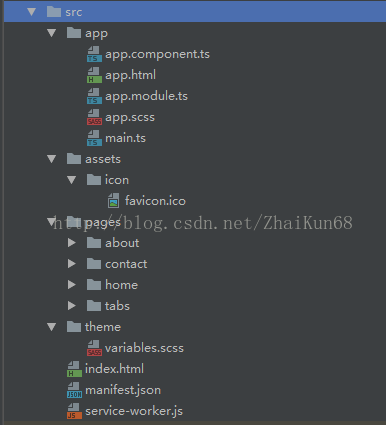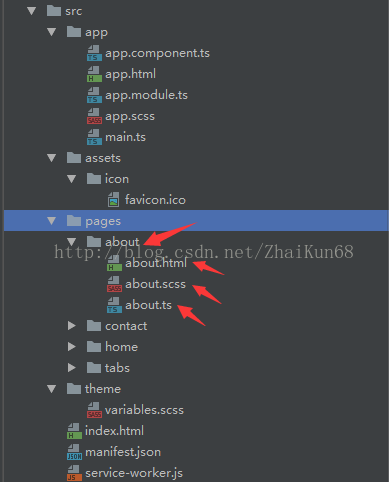在之前的文章中有提到项目的源码全部存放在项目根目录的src文件夹,我们之后所有的代码开发也是在该目录进行
app文件夹
app.component.ts 根组件
import { Component } from '@angular/core';import { Platform } from 'ionic-angular';import { StatusBar } from '@ionic-native/status-bar';import { SplashScreen } from '@ionic-native/splash-screen';import { TabsPage } from '../pages/tabs/tabs';@Component({templateUrl: 'app.html'})export class MyApp {rootPage:any = TabsPage;constructor(platform: Platform, statusBar: StatusBar, splashScreen: SplashScreen) {platform.ready().then(() => {// Okay, so the platform is ready and our plugins are available.// Here you can do any higher level native things you might need.statusBar.styleDefault();splashScreen.hide();});}}
平时所说的视图,主要定义了app整体的视觉表现,比如根页面、状态栏、启动界面等等。
app.html APP的根界面
<ion-nav [root]="rootPage"></ion-nav>
相当于Android的MainActivity界面显示的内容
app.module.ts 根模块文件
import { NgModule, ErrorHandler } from '@angular/core';import { BrowserModule } from '@angular/platform-browser';import { IonicApp, IonicModule, IonicErrorHandler } from 'ionic-angular';import { MyApp } from './app.component';import { AboutPage } from '../pages/about/about';import { ContactPage } from '../pages/contact/contact';import { HomePage } from '../pages/home/home';import { TabsPage } from '../pages/tabs/tabs';import { StatusBar } from '@ionic-native/status-bar';import { SplashScreen } from '@ionic-native/splash-screen';@NgModule({declarations: [MyApp,AboutPage,ContactPage,HomePage,TabsPage],imports: [BrowserModule,IonicModule.forRoot(MyApp)],bootstrap: [IonicApp],entryComponents: [MyApp,AboutPage,ContactPage,HomePage,TabsPage],providers: [StatusBar,SplashScreen,{provide: ErrorHandler, useClass: IonicErrorHandler}]})export class AppModule {}
ionic是基于angular的,而angular是完全模块化的。配置项目中使用到的模块、组件、服务、管道、指令等
app.scss
main.ts
入口文件
import { platformBrowserDynamic } from '@angular/platform-browser-dynamic';import { AppModule } from './app.module';platformBrowserDynamic().bootstrapModule(AppModule);
在最初接触到网页开发时,都是用到一个js,就在HTML中增加一个标签,现在只需要调用入口文件,然后由入口文件去引入其它依赖的文件。
assets文件夹
pages文件夹
存放APP中用到的所有界面,其下的一个文件夹就是独立的一个界面
每一个界面文件夹下存放三个文件,分别是界面、模板样式和业务处理逻辑(用TypeScript—-JavaScript的超级 语法编写)
theme文件夹
APP主题样式文件

